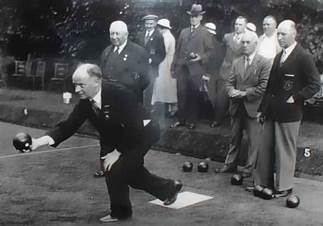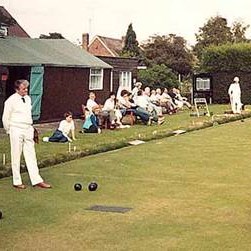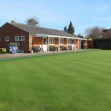History
The Club was formed as a result of meetings held in the Court Room of the Twyford Almshouses in 1935 under the Chairmanship of Dr Lionel Furber of Wargrave Road. These meetings identified an old gravel pit site behind the old King's Arms in Wargrave Road.
Following negotiations with W H Brakspear & Sons a green was laid on this site at the breweries expense by Tommy Carlile, nurseryman of Carlile Corner, using Butser turves from the chalk downs behind Portsmouth. The site was then rented to the Club in 1936 at a peppercorn rent.
The Chairman of the brewery, John Chalcraft, became the Club's first President and retained that position until his death 49 years later in June 1985.
The Club was formally opened on Wednesday the 3rd June 1936 by Thomas Campbell-Dykes, President of the Berkshire County Bowling Association, seen here bowling the first wood on the green.

Notable among those present was Albert Barker later to became the landlord of the King's Arms, a County bowler, County Captain and Chairman of the Bowling Club. Also present was Reggie Cole who remained a member for 63 years until his death in 1999. Like Albert Reggie had a long and distinguished record of service to the Club including membership of teams which won County and British Legion honours, Captaincy of the Club six times and greenkeeper for some ten years in the 60s and 70s before becoming the Club President from 1987 until his death in 1999.
As there were no official bowls fixtures in 1936 five local clubs - Bearwood, Bulmershe, Hurst, Maidenhead Thicket and Wargrave each kindly arranged two home and two away games to give the new Club an opportunity for match play. For home games the Men's Club opposite the green was used as a changing room and for teas as there was no pavilion. Within a fortnight of its opening though the Club had obtained an old bicycle shed and erected it just inside a gate in the middle of the King's Arms end of the green to store bowls gear and tools.
In 1937 the Club became affiliated to the Berkshire County Bowling Association and the ladies, not to be outdone by their husbands, formed a ladies section. Among the wives was Phyllis Barker who later became a County player and Captain of the Berkshire County Women's Bowling Association.
The War years brought many evacuees to Twyford. Among them were several good bowlers including Bill Thatcher, a bowls international, who taught members a lot of good bowling tactics. These stood the Club in good stead as the post War years saw it in its heydays.
In the late 1940s Herbert Roberts, Manager of Hare Hatch Estate, obtained the basis of the old wooden pavilion for the Club (formerly a site hut for building workers) and in the late 1950s Reg Arnold, a Twyford Builder, added the Ladies' room and very necessary Gents' toilet block.
In 1967 Twyford won the County Double Fours and one of its bowlers, Jimmy Boyd, a speedway rider for Walthamstow Wolves, won the County Singles Championship.
But by the 1970s most of the earlier players had died or moved away and the Club went into decline. Membership dropped to the low 30s and the green deteriorated due to subsidence. Its origins as a gravel pit and rubbish tip were beginning to tell. The very dry summer of 1976 and the ban on watering had such a disastrous effect that no home games could be played in the latter half of the season or for the whole of 1977. The subsidence required a great deal of levelling work by both the Club and outside contractors. Since then, though, there has been a gradual improvement in the green such that now it is in the best condition it has been in for many years.
In 1986 the Club obtained a formal lease on its premises and as the popularity of bowls increased membership grew until it reached 107 in 1995.
With this increase and the associated rise in income it proved possible to install an automatic watering system to cope with drought conditions and to amass a Building Fund for a future new Pavilion to ensure the continuance of the Club for many years to come.
To a large extent the existence of the Building Fund proved fortuitous as around about midnight on the 3rd/4th June 1997 a fire at the green started in a shed and spread to the main pavilion causing extensive damage to the western end of the main clubroom. Internally the kitchen area was devastated, it was left with no floor, very little roof and no electrics. The ladies changing room floor was also suspect. In fact the damage was so bad that the entire building was written off by the Club's insurers. Subsequently following protracted, extensive and difficult, negotiations with the Club's landlord and the planning authority a larger, replacement brick building (the current pavilion) was erected in early 1999 and officially opened on the 24th April by Bill Wilson, the then President of Berkshire County Bowling Association .
Over the life of the Club its character has changed little. It has always been a friendly village Club.
The Membership has, however, changed reflecting the change in the character of the village. Initially members were local shopkeepers and tradesman, but now they are more likely to be people working in London, Maidenhead or Reading or retired people.
The Club however still welcomes members of all ages from all sections of society. The only criteria is that members should live in the general area of Twyford and East Berkshire and have a desire to play bowls and enjoy themselves.



